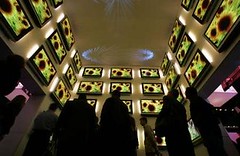Info on New TVs

r671409371
Originally uploaded by votaaj.
The following was from a Reuter's article as seen on My Yahoo!
Technology - Reuters
Reuters
PluggedIn: New TVs Gain Following -- But Complexity a Worry
Sat Jan 15, 8:40 AM ET
>
By Ben Berkowitz
LOS ANGELES (Reuters) - Want a big-screen television set before this year's Super Bowl? Better figure out if you want LCD, DLP, PDP or CRT, and if you want your picture to be HD, ED or plain old SD.
Photo
Confused? Of course. Buying a television is quickly becoming one of the most confounding decisions in all of home entertainment.
The explosion of new television formats is creating a sales boom for the electronics industry -- even if consumers don't always know what they are buying. Digital television sales will jump to 10.77 million units in 2005 from 6.97 million in 2004, the Consumer Electronics Association forecasts.
"The consumer is being kind of lulled into the digital television world by the look and feel of these very lightweight flat panel TVs," said Rosemary Abowd, director of flat-panel display research at Pacific Media Associates.
Scores of the shiny new products were on display at the recent Consumer Electronics Show, as companies showed off the latest and greatest in TV technology, including the ultimate in concept models, a 102-inch set from Samsung.
For the average consumer, Samsung's jumbotron-for-the-living room might be a big reach financially, since it is expected to sell for about the price of a new car. For most consumers, big-screen dreams are probably more in the 40- to 50-inch category, where prices are falling to $2,000 or less for entry-level models.
But it's not just the big-screen televisions that are fighting for consumers' attention. A plethora of new digital services are vying to be the ones to deliver programing for the new TV sets, including extra packages for digital cable or satellite services, and even digital channels broadcast over the air by local stations.
Some worry that the complicated offerings will be enough of a turn-off that consumers will decide not to buy, or to delay their purchases -- something the industry can ill afford, given that it is banking on relatively strong growth for the next few years.
"My reaction generally is: who's going to put themselves through this?" Abowd said. "Yes the prices are coming down and that's attractive but the components that feed the displays are still very complicated."
To help sort through the maize of new toys and tools, a few definitions are in order.:
-- HDTV, or high-definition television, is digital television in a wide-screen display (a 16-by-9 ratio) with a resolution of at least 720 progressively-scanned lines or 1,080 interlaced lines. (Progressive scanning puts all the lines of a picture on the TV one after the other, while interlaced scanning does all the odd lines first and then goes back for the evens).
-- EDTV/SDTV. Lower down the digital picture quality scale is enhanced-definition television (EDTV) and lower still is standard-definition television (SDTV).
-- An HDTV monitor is a television that can display HD with the addition of a separate device to tune the digital signals.
-- An integrated HDTV has the tuner built in to the set.
-- A High-Definition Multimedia Interface, most often called HDMI, connects an HD tuner to an HDTV monitor. It is a successor to the older Digital Visual Interface, or DVI, and cables exist to adapt DVI to HDMI.
Then of course there are the different types of HDTVs.
-- Cathode ray tubes, or CRTs, are the most bulky and the least expensive HDTVs. Technologically similar to regular old TV sets, they can weigh close to 150 pounds with a large footprint.
-- Plasma televisions, sometimes referred to as PDPs, are bright, have large viewing angles, scale easily to sizes 60 inches and above, and are thin enough to hang on walls.
-- LCDs, or liquid crystal displays, are bright with high resolutions, though they have traditionally been smaller than plasma screens and suffered from some blurring during high-speed motion like sporting events.
-- DLP, or digital light projection, sets use very small mirrors to reflect light and are relatively thin and low-weight in the vein of plasma sets. They are also renowned for their brightness though are said to suffer some in dark rooms.
All of these technologies are improving rapidly, and technical deficiencies that have cropped up with each are starting to disappear.
So the $64,000 question is -- is it going to cost $64,000 to get a big-screen HDTV? Not hardly.
Assuming the buyer wants a screen of at least 40 inches and is willing to pay for a separate tuner, the online stores of major retailers offer CRT HD sets from $1,000, DLP sets from $2,500, LCD sets from $2,650, and plasmas from $3,800.
Brand choice is an issue too -- Sony Corp (NYSE:SNE - news) (news - web sites). (6758.T) is pushing LCD displays, while Matsushita's (6991.T) Panasonic brand is firmly in the plasma camp and companies like Samsung Corp. (000830.KS) and Thomson (TMS.PA) have stood back to push a wide range of styles.
"There's still a whole lot to this digital television revolution beyond the sexy flat panel television," Abowd said.





0 Comments:
Post a Comment
<< Home